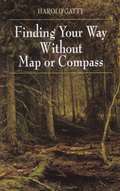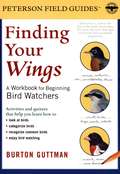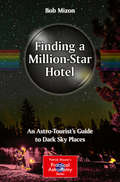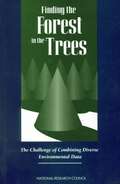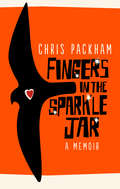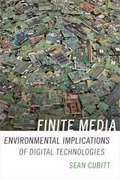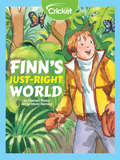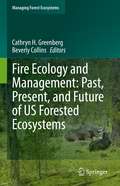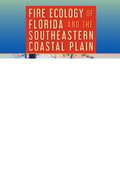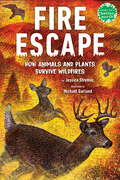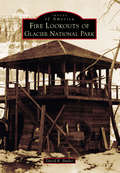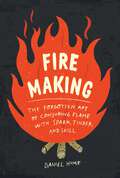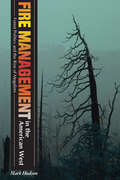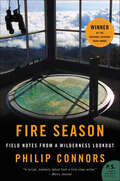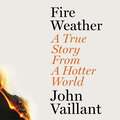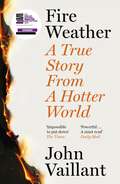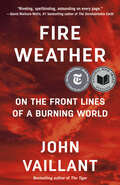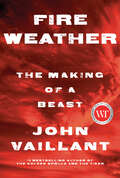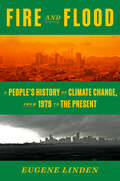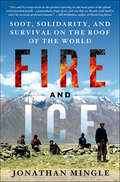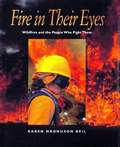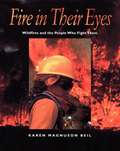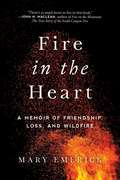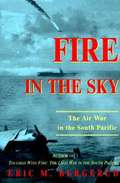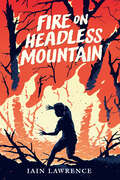- Table View
- List View
Finding Your Way Without Map or Compass
by Harold GattyDuring his remarkable lifetime, Harold Gatty became one of the world's great navigators (in 1931, he and Wiley Post flew around the world in a record-breaking eight days) and, to the benefit of posterity, recorded in this book much of his accumulated knowledge about pathfinding both on land and at sea.Applying methods used by primitive peoples and early explorers, the author shows how to determine location, study wind directions and reflections in the sky, even how to use the senses of smell and hearing to find your way in the wilderness, in a desert, in snow-covered areas, and on the ocean. By observing birds and other animals, weather patterns, vegetation, shifting sands, patterns of snow fields, and the positions of the sun, moon, and stars, would-be explorers can learn to estimate distances and find their way without having to rely on a map or a compass.The wealth of valuable data and advice in this volume — much of it unavailable elsewhere — makes it indispensable for hikers, bikers, scouts, sailors, and outdoorsmen — all those who might find themselves stranded or lost in an unfamiliar area. Through careful study of this book and its lessons, pathfinders can learn to interpret signs in the natural world to find their way in almost any kind of terrain.
Finding Your Wings
by Burton S. GuttmanA Workbook for Beginning Bird WatchersNo other book for beginning bird watchers involves the reader so actively in the exciting first steps of learning to watch birds. This workbook is filled with quizzes and exercises that prepare the reader for going birding and help beginners develop a sense of accomplishment and progress. With each chapter covering a different aspect of bird watching, the author guides readers along a threefold path: learning how to really see birds, how to sort birds by category, and how to learn the easiest birds first. Plenty of room is provided for writing and sketching, and answers are supplied in the back of the book.
Finding a Million-Star Hotel
by Bob MizonBob Mizon, one of the world's best known campaigners against the veil of light pollution that has taken away the starry sky from most of the world's population, takes readers to a hundred places in the UK and the USA where the wonders of the night sky might still be enjoyed in perfect or near-perfect night skies. Visiting small hotels and simple campsites, and savoring vast dark-sky reserves where the night sky is actively protected, The Million-Star Hotel celebrates the black skies of yesteryear - which may become a reality for more and more of us as modern technology reins in lighting and puts it only where needed. How can you prepare for your stay beneath the stars? What astronomy can you do during the daytime? What kind of equipment will you need? Questions such as these are answered, and if town dwellers return inspired - and, Bob hopes, also inspired to look with fresh eyes at their own local lighting - there is enough information here for them to equip themselves for some urban astronomy too.
Finding the Forest in the Trees: The Challenge of Combining Diverse Environmental Data
by Committee for a Pilot Study on Database InterfacesDuring the last few decades of the 20th century, the development of an array of technologies has made it possible to observe the Earth, collect large quantities of data related to components and processes of the Earth system, and store, analyze, and retrieve these data at will. Over the past ten years, in particular, the observational, computational, and communications technologies have enabled the scientific community to undertake a broad range of interdisciplinary environmental research and assessment programs. Sound practice in database management are required to deal with the problems of complexity in such programs and a great deal of attention and resources has been devoted to this area in recent years. However, little guidance has been provided on overcoming the barriers frequently encountered in the interfacing of disparate data sets. This book attempts to remedy that problem by providing analytical and functional guidelines to help researchers and technicians to better plan and implement their supporting data management activities.
Fingers in the Sparkle Jar: A Memoir
by Chris PackhamVoted the UK’s Favourite Nature BookThe memoir that inspired Chris Packham's BBC documentary, Asperger’s and MeEvery minute was magical, every single thing it did was fascinating and everything it didn't do was equally wondrous, and to be sat there, with a Kestrel, a real live Kestrel, my own real live Kestrel on my wrist! I felt like I'd climbed through a hole in heaven's fence.An introverted, unusual young boy, isolated by his obsessions and a loner at school, Chris Packham only felt at ease in the fields and woods around his suburban home. But when he stole a young Kestrel from its nest, he was about to embark on a friendship that would teach him what it meant to love, and that would change him forever. In his rich, lyrical and emotionally exposing memoir, Chris brings to life his childhood in the 70s, from his bedroom bursting with fox skulls, birds' eggs and sweaty jam jars, to his feral adventures. But pervading his story is the search for freedom, meaning and acceptance in a world that didn’t understand him.Beautifully wrought, this coming-of-age memoir will be unlike any you've ever read.
Finite Media: Environmental Implications of Digital Technologies
by Sean CubittWhile digital media give us the ability to communicate with and know the world, their use comes at the expense of an immense ecological footprint and environmental degradation. In Finite Media Sean Cubitt offers a large-scale rethinking of theories of mediation by examining the environmental and human toll exacted by mining and the manufacture, use, and disposal of millions of phones, computers, and other devices. The way out is through an eco-political media aesthetics, in which people use media to shift their relationship to the environment and where public goods and spaces are available to all. Cubitt demonstrates this through case studies ranging from the 1906 film The Story of the Kelly Gang to an image of Saturn taken during NASA's Cassini-Huygens mission, suggesting that affective responses to images may generate a populist environmental politics that demands better ways of living and being. Only by reorienting our use of media, Cubitt contends, can we overcome the failures of political elites and the ravages of capital.
Finn's Just-Right World
by Charnan SimonFinn is bored! She is stuck inside with her family because of the cold weather. While she tries to convince her family to go to the zoo, her brother tries to teach her about global warming. When Finn is skeptical, her father decides to take the whole family to the zoo to teach them about greenhouse gases and their effect on Earth.
Fire Ecology and Management: Past, Present, and Future of US Forested Ecosystems (Managing Forest Ecosystems #39)
by Beverly Collins Cathryn H. GreenbergThis edited volume presents original scientific research and knowledge synthesis covering the past, present, and potential future fire ecology of major US forest types, with implications for forest management in a changing climate. The editors and authors highlight broad patterns among ecoregions and forest types, as well as detailed information for individual ecoregions, for fire frequencies and severities, fire effects on tree mortality and regeneration, and levels of fire-dependency by plant and animal communities. The foreword addresses emerging ecological and fire management challenges for forests, in relation to sustainable development goals as highlighted in recent government reports. An introductory chapter highlights patterns of variation in frequencies, severities, scales, and spatial patterns of fire across ecoregions and among forested ecosystems across the US in relation to climate, fuels, topography and soils, ignition sources (lightning or anthropogenic), and vegetation. Separate chapters by respected experts delve into the fire ecology of major forest types within US ecoregions, with a focus on the level of plant and animal fire-dependency, and the role of fire in maintaining forest composition and structure. The regional chapters also include discussion of historic natural (lightning-ignited) and anthropogenic (Native American; settlers) fire regimes, current fire regimes as influenced by recent decades of fire suppression and land use history, and fire management in relation to ecosystem integrity and restoration, wildfire threat, and climate change. The summary chapter combines the major points of each chapter, in a synthesis of US-wide fire ecology and forest management into the future.This book provides current, organized, readily accessible information for the conservation community, land managers, scientists, students and educators, and others interested in how fire behavior and effects on structure and composition differ among ecoregions and forest types, and what that means for forest management today and in the future.
Fire Ecology of Florida and the Southeastern Coastal Plain
by Reed F. NossAn overview of the importance of fire to ecosystems in the Southeast, with guidance on how to best conduct controlled burns in the regionA biodiversity hotspot, Florida is home to many ecosystems and species that evolved in the presence of frequent fire. In this book, Reed Noss discusses the essential role of fire in generating biodiversity and offers best practices for using fire to keep the region's ecosystems healthy and resilient. Reviewing several lines of evidence, Noss shows that fire has been important to the southeastern Coastal Plain for tens of millions of years. He explains how the region's natural fire regimes are connected to its climate, high rate of lightning strikes, physical chemistry, and vegetation. But urbanization and active fire suppression have reduced the frequency and extent of fires. Noss suggests the practice of controlled burning can and should be improved to protect fire-dependent species and natural communities from decline and extinction. Noss argues that fire managers should attempt to simulate natural fire regimes when conducting controlled burns. Based on what the species of the Southeast likely experienced during their evolutionary histories, he makes recommendations about pyrodiversity, how often and in what seasons to burn, the optimal heterogeneity of burns, mechanical treatments such as cutting and roller-chopping, and the proper use of fuel breaks. In doing so, Noss is the first to apply the new discipline of evolutionary fire ecology to a specific region. This book is a fascinating history of fire ecology in Florida, an enlightening look at why fire matters to the region, and a necessary resource for conservationists and fire managers in the state and elsewhere.
Fire Escape: How Animals and Plants Survive Wildfires (Books for a Better Earth)
by Jessica StremerA timely middle grade nonfiction overview of the incredible ways animals detect, respond, and adapt to wildfires, as well as how climate change is affecting the frequency and severity of these devastating events in nature.Goats and beavers. Drones and parachutes. Pinecones and beetles. What do they have in common? Believe it or not, they are all crucial tools in fighting, preventing, and adapting to wildfires!These vicious fires are spreading faster and burning hotter than at any other time in history. Ongoing droughts, warming weather, and a history of poor forest management have extended the traditional wildfire season beyond the summer months. It is a matter of life and death for wildlife worldwide.This breathtaking nonfiction book focuses on unique angles to a hot topic, including injury rehabilitation efforts, species that use wildfires to their advantage, how to help area repopulation, and the animals that help to prevent/fight wildfires. A riveting, kid friendly text is accompanied by stunning woodcut illustrations and full-color photographs, as well as extensive back matter with glossary, sources, and index.Books for a Better Earth are designed to inspire children to become active, knowledgeable participants in caring for the planet they live on.A Junior Library Guild Gold Standard Selection
Fire Lookouts of Glacier National Park
by David R. ButlerThe first fire lookouts in the Glacier National Park region were simply high points atop mountain peaks with unimpeded views of the surrounding terrain. Widespread fires in the 1910s and 1920s led to the construction of more permanent lookouts, first as wooden pole structures and subsequently as a variety of one- and two-story cabin designs. Cooperating lookouts in Glacier Park, the Flathead National Forest, and the Blackfeet Indian Reservation provided coverage of forests throughout Glacier National Park. Beginning in the 1950s, many of the lookouts were decommissioned and eventually destroyed. This volume tells the story of the rise and fall of the extensive fire lookout network that protected Glacier National Park during times of high fire danger, including lookouts still operating today.
Fire Making: The Forgotten Art Of Conjuring Flame With Spark, Tinder, And Skill
by Daniel HumeA Richly Illustrated Guide to Making Fire Without a Lighter If you ask outdoorsman Daniel Hume for the fastest, most practical way to start a fire, he’ll tell you: Use a match. But he probably won’t stop there. For Hume, conjuring flame is an art form, and seeking out the old ways is a passion that has led him the world over. Fire Making is your guide to techniques Hume has learned firsthand—from the San people in Namibia, the Mangyan of the Philippines, and other masters. You’ll fall in love with the craft of coaxing spark into flame using only handmade tools. Learn about: The bow drill, the fire plow, and other traditional fire–starters Every type of tinder, from birch bark to fungus Overcoming strong winds, freezing cold, and other challenges Plus modern fire–making hacks, such as using foil and a battery. Hume’s crystal clear steps, all helpfully illustrated, make it easy to start and maintain the perfect fire for any need—from quickly boiling a pot of water, to setting up camp . . . to the sheer joy of seeing your efforts rewarded with a blaze of warmth and light.
Fire Management in the American West: Forest Politics and the Rise of Megafires (G - Reference, Information And Interdisciplinary Subjects Ser.)
by Mark HudsonMost journalists and academics attribute the rise of wildfires in the western United States to the USDA Forest Service's successful fire-elimination policies of the twentieth century. However, in Fire Management in the American West, Mark Hudson argues that although a century of suppression did indeed increase the hazard of wildfire, the responsibility does not lie with the USFS alone. The roots are found in the Forest Service's relationships with other, more powerful elements of society--the timber industry in particular. Drawing on correspondence both between and within the Forest Service and the major timber industry associations, newspaper articles, articles from industry outlets, and policy documents from the late 1800s through the present, Hudson shows how the US forest industry, under the constraint of profitability, pushed the USFS away from private industry regulation and toward fire exclusion, eventually changing national forest policy into little more than fire policy. More recently, the USFS has attempted to move beyond the policy of complete fire suppression. Interviews with public land managers in the Pacific Northwest shed light on the sources of the agency's struggles as it attempts to change the way we understand and relate to fire in the West. Fire Management in the American West will be of great interest to environmentalists, sociologists, fire managers, scientists, and academics and students in environmental history and forestry.
Fire Season: Field Notes from a Wilderness Lookout
by Philip Connors“Fire Season both evokes and honors the great hermit celebrants of nature, from Dillard to Kerouac to Thoreau—and I loved it.”—J.R. Moehringer, author of The Tender Bar“[Connors’s] adventures in radical solitude make for profoundly absorbing, restorative reading.”—Walter Kirn, author of Up in the AirPhillip Connors is a major new voice in American nonfiction, and his remarkable debut, Fire Season, is destined to become a modern classic. An absorbing chronicle of the days and nights of one of the last fire lookouts in the American West, Fire Season is a marvel of a book, as rugged and soulful as Matthew Crawford’s bestselling Shop Class as Soulcraft, and it immediately places Connors in the august company of Edward Abbey, Annie Dillard, Aldo Leopold, Barry Lopez, and others in the respected fraternity of hard-boiled nature writers.
Fire Weather: A True Story from a Hotter World
by John VaillantA stunning account of this century's most intense urban fire, and a panoramic exploration of the rapidly changing relationship between fire and humankind. In May 2016, Fort McMurray, Alberta, the hub of Canada's oil industry, was overrun by wildfire. The multi-billion-dollar disaster turned entire neighbourhoods into firebombs and drove 90,000 people from their homes in a single afternoon. Through the story of this apocalyptic conflagration, John Vaillant explores the past and the future of our ever-hotter, more flammable world.For hundreds of millennia, fire has been a partner in our evolution, shaping culture and civilization. Yet in our age of intensifying climate change, we are seeing its destructive power unleashed in ways never before witnessed by human beings. With masterly prose and cinematic style, Vaillant delves into the intertwined histories of the oil industry and climate science, the unprecedented devastation wrought by modern wildfires, and the lives forever changed by these disasters. Fire Weather is an urgent book for our new century of fire.'John Vaillant is one of the great poetic chroniclers of the natural world' David Wallace-Wells'A towering achievement; an immense work of research, reflection and imagination' Robert Macfarlane(P) 2023 Penguin Audio
Fire Weather: A True Story from a Hotter World
by John Vaillant'Astounding on every page. John Vaillant is one of the great poetic chroniclers of the natural world' David Wallace-Wells'A towering achievement; an immense work of research, reflection and imagination' Robert MacfarlaneA gripping account of this century's most intense urban fire, and a panoramic exploration of the rapidly changing relationship between humanity and fire's fierce energy.In May 2016, Fort McMurray, Alberta, the hub of Canada's oil industry, was overrun by wildfire. The multi-billion-dollar disaster turned entire neighbourhoods into firebombs and drove 90,000 people from their homes in a single afternoon. Through the story of this apocalyptic conflagration, John Vaillant explores the past and the future of our ever-hotter, more flammable world.For hundreds of millennia, fire has been a partner in our evolution, shaping culture and civilization. Yet in our age of intensifying climate change, we are seeing its destructive power unleashed in ways never before witnessed by human beings. With masterly prose and cinematic style, Vaillant delves into the intertwined histories of the oil industry and climate science, the unprecedented devastation wrought by modern wildfires, and the lives forever changed by these disasters. Fire Weather is urgent reading for our new century of fire.
Fire Weather: On the Front Lines of a Burning World
by John VaillantPULITZER PRIZE FINALIST • A NEW YORK TIMES TOP TEN BOOK OF THE YEAR • FINALIST FOR THE NATIONAL BOOK AWARD IN NONFICTION • A stunning account of a colossal wildfire and a panoramic exploration of the rapidly changing relationship between fire and humankind from the award-winning, best-selling author of The Tiger and The Golden Spruce • Winner of the Baillie Gifford Prize for Non-FictionA BEST BOOK OF THE YEAR: The New York Times, The Washington Post, The New Yorker, TIME, NPR, Slate, and Smithsonian&“Grips like a philosophical thriller, warns like a beacon, and shocks to the core." —Robert Macfarlane, bestselling author of Underland&“Riveting, spellbinding, astounding on every page.&” —David Wallace-Wells, #1 bestselling author of The Uninhabitable EarthIn May 2016, Fort McMurray, the hub of Canada&’s oil industry and America&’s biggest foreign supplier, was overrun by wildfire. The multi-billion-dollar disaster melted vehicles, turned entire neighborhoods into firebombs, and drove 88,000 people from their homes in a single afternoon. Through the lens of this apocalyptic conflagration—the wildfire equivalent of Hurricane Katrina—John Vaillant warns that this was not a unique event, but a shocking preview of what we must prepare for in a hotter, more flammable world.Fire has been a partner in our evolution for hundreds of millennia, shaping culture, civilization, and, very likely, our brains. Fire has enabled us to cook our food, defend and heat our homes, and power the machines that drive our titanic economy. Yet this volatile energy source has always threatened to elude our control, and in our new age of intensifying climate change, we are seeing its destructive power unleashed in previously unimaginable ways.With masterly prose and a cinematic eye, Vaillant takes us on a riveting journey through the intertwined histories of North America&’s oil industry and the birth of climate science, to the unprecedented devastation wrought by modern forest fires, and into lives forever changed by these disasters. John Vaillant&’s urgent work is a book for—and from—our new century of fire, which has only just begun.
Fire Weather: The Making of a Beast
by John Vaillant#1 NATIONAL BESTSELLERWINNER OF THE BAILLIE GIFFORD PRIZE FOR NONFICTION • FINALIST FOR THE HILARY WESTON WRITERS' TRUST PRIZE FOR NONFICTION • FINALIST FOR THE NATIONAL BOOK AWARD IN NONFICTION • ONE OF THE NEW YORK TIMES&’ TOP TEN BOOKS OF THE YEAR • A stunning account of the colossal wildfire at Fort McMurray, and a panoramic exploration of the rapidly changing relationship between fire and humankind from the award-winning, best-selling author of The Tiger and The Golden Spruce.Named a Best Book of the Year by The Guardian • TIME • The Globe and Mail • The New Yorker • Financial Times • CBC • Smithsonian • Air Mail Weekly • Slate • NPR • Toronto Star • The Washington Post • The Times • Orion MagazineIn May 2016, Fort McMurray, the hub of Canada's petroleum industry and America's biggest foreign supplier, was overrun by wildfire. The multi-billion-dollar disaster melted vehicles, turned entire neighborhoods into firebombs, and drove 88,000 people from their homes in a single afternoon. Through the lens of this apocalyptic conflagration—the wildfire equivalent of Hurricane Katrina—John Vaillant warns that this was not a unique event but a shocking preview of what we must prepare for in a hotter, more flammable world. For hundreds of millennia, fire has been a partner in our evolution, shaping culture, civilization, and, very likely, our brains. Fire has enabled us to cook our food, defend and heat our homes, and power the machines that drive our titanic economy. Yet this volatile energy source has always threatened to elude our control, and in our new age of intensifying climate change, we are seeing its destructive power unleashed in previously unimaginable ways. With masterly prose and a cinematic eye, Vaillant takes us on a riveting journey through the intertwined histories of North America's oil industry and the birth of climate science, to the unprecedented devastation wrought by modern forest fires, and into lives forever changed by these disasters. John Vaillant's urgent work is a book for—and from—our new century of fire, which has only just begun.
Fire and Flood: A People's History of Climate Change, from 1979 to the Present
by Eugene LindenFrom a writer and expert who has been at the center of the fight for more than thirty years, a brilliant, big-picture reckoning with our shocking failure to address climate change. Fire and Flood focuses on the malign power of key business interests, arguing that those same interests could flip the story very quickly—if they can get ahead of a looming economic catastrophe.Eugene Linden wrote his first story on climate change, for Time magazine, in 1988; it was just the beginning of his investigative work, exploring all ramifications of this impending disaster. Fire and Flood represents his definitive case for the prosecution as to how and why we have arrived at our current dire pass, closing with his argument that the same forces that have confused the public&’s mind and slowed the policy response are poised to pivot with astonishing speed, as long-term risks have become present-day realities and the cliff&’s edge is now within view. Starting with the 1980s, Linden tells the story, decade by decade, by looking at four clocks that move at different speeds: the reality of climate change itself; the scientific consensus about it, which always lags reality; public opinion and political will, which lag further still; and, perhaps most important, business and finance. Reality marches on at its own pace, but the public will and even the science are downstream from the money, and Fire and Flood shows how devilishly effective moneyed climate-change deniers have been at slowing and even reversing the progress of our collective awakening. When a threat means certain but future disaster, but addressing it means losing present-tense profit, capitalism&’s response has been sadly predictable. Now, however, the seasons of fire and flood have crossed the threshold into plain view. Linden focuses on the insurance industry as one loud canary in the coal mine: fire and flood zones in Florida and California, among other regions, are now seeing what many call &“climate redlining.&” The whole system is teetering on the brink, and the odds of another housing collapse, for starters, are much higher than most people understand. There is a path back from the cliff, but we must pick up the pace. Fire and Flood shows us why, and how.
Fire and Ice: Soot, Solidarity, and Survival on the Roof of the World
by Jonathan MingleHigh in the Himalayan valley of Zanskar in northwest India sits a village as isolated as the legendary Shangri-La. Long fed by runoff from glaciers and lofty snowfields, Kumik—a settlement of thirty nine mud brick homes—has survived and thrived in one of the world's most challenging settings for a thousand years. But now its people confront an existential threat: chronic, crippling drought, which leaves the village canal dry and threatens to end their ancient culture of farming and animal husbandry. Fire and Ice weaves together the story of Kumik's inspiring response to this calamity with the story of black carbon. Black carbon from inefficient fires - the particulate residue that makes soot dark - is the second largest contributor to global warming after carbon dioxide. It's also a key ingredient of the air pollution that public health experts regard as humanity's greatest environmental health risk worldwide: soot-laden smoke from household hearth fires and outdoor sources combine to kill over seven million people around the world every year. Jonathan Mingle describes the joys and struggles of daily life in the Zanskar Valley, where villagers are buffeted by powerful environmental and economic forces, while also tracing black carbon's dark fingerprints outward from Kumik and around the world. Mingle investigates its impacts on snow, ice, and water from Mt. Everest to California, and the silent health epidemic it fuels from New York to New Delhi. Combining cultural history, detailed reportage, climate and energy science and dramatic storytelling, Fire and Ice is a profound examination of the global challenges of averting climate chaos and lifting billions out of energy poverty and water scarcity. Can Kumik's people come together to reinvent fire, harness what remains of their life-sustaining ice, and reinvigorate their traditions of solidarity, in time to save themselves? Can the rest of us rise to the same challenge? Fire and Ice connects these questions with the work of enterprising scientists, engineers, entrepreneurs and activists around the world, in a narrative that combines mythology, reason, humor, persistence, and hope in a race against a global clock.
Fire in Their Eyes: Wildfires and the People Who Fight Them
by Karen Magnuson BeilDepicts the training, equipment, and real-life experiences of people who risk their lives to battle wildfires, as well as people who use fire for ecological reasons.
Fire in Their Eyes: Wildfires and the People Who Fight Them
by Karen Magnuson BeilWhat drives some people to stand in the path of a wall of flame? Who are these brave, foolhardy, visionary firefighters? This intimate look at the elite groups that fight wildfires explores the trials, tragedies, and triumphs of these courageous few as they battle wilderness blazes from Alaska to Maine. From the grueling training of a smokejumper class in Montana, through harrowing fights with some up-close-and-personal wildfires, to a group of inspired conservationists who use fire as a tool for preservation, Karen Magnuson Beil takes readers where only a few have ventured--into the heart of one of nature's most destructive and unpredictable forces: fire.
Fire in the Heart: A Memoir of Friendship, Loss, and Wildfire
by Mary EmerickFIRE IN THE HEART is a powerful memoir by a woman, once a shy, insecure schoolgirl, who reinvented herself as a professional wildland fire fighter. Determined to forge herself into a stronger, braver person, Mary climbs to heights she never imagined for herself, eventually directing blazes across the country. Filled with literal struggles for survival, tough choices and Mary's burning passion for what she does, Fire in the Heart, is an unflinching account of one woman's relationship with fire. But when she loses someone she loves to the famous Storm King Mountain forest fire in Colorado, which killed fourteen firefighters, Mary faces the hardest choice of her life; to stay in the game or turn back and try to find the woman she used to be. It is both a thrilling memoir about life-threatening work and a meditation on identity, strength, bravery, bonds, and survivor's guilt.
Fire in the Sky: The Air War in the South Pacific
by Eric M. BergerudThis book explores the technology, tactics, 3-D battlefield, leadership, living conditions, medical challenges and morale of the combatants during WWII in the air over the Pacific.
Fire on Headless Mountain
by Iain LawrenceSeparated from his siblings in the midst of a dangerous forest fire, 11-year-old Virgil must find a way to survive using only his wits and the lessons his late mother taught him about the wilderness.Virgil is making his older siblings trek to a mountain lake on a trip unlike any they&’ve have taken before. They carry precious cargo: the ashes of their beloved mother, who asked that her remains be scattered at her favorite spot. But when a forest fire is sparked by a bolt of lightning at the exact moment when their van breaks down, the journey quickly turns to disaster. While the oldest, Josh, is gone to find help, Virgil and his sister, Kaitlyn, spot fleeing animals and soon see flames flickering above the tree line. Once the sky begins to darken with the haze of burning timber, Virgil finds himself separated from his sister and left alone in the wilderness. He isn&’t sure he can make it, but with the memory of his late mother, a science teacher, and all her lessons to guide him, he quickly learns that not everything has a perfect explanation and survival starts with letting go. Fire on Headless Mountain showcases not only the overwhelming beauty and terrifying power of nature, but also the gift of memory when facing great emotional and physical trials. Lessons on ecosystems and fire safety are also seamlessly interwoven into this thrilling adventure tale. Praise for DEADMAN&’S CASTLE &“Lawrence, the Canadian writer whose High Seas Trilogy encompassed three chilling historical novels, now offers a menacing, contemporary tale of dread, danger, and revenge. Portraying family dynamics and middle-school antics with equal insight and attention to detail, Igor&’s first-person narrative is absorbing.&”–Booklist &“Featuring effective worldbuilding, this is a great, suspenseful tale of terror for upper middle graders&”.–School Library Journal&“Friendship difficulties provide a contrast and an anchor to the terrifying threat, and the various plot elements are deftly tied together in a fitting twist that will have readers quickly turning the pages. Filled with suspense and intrigue."–Kirkus Reviews
